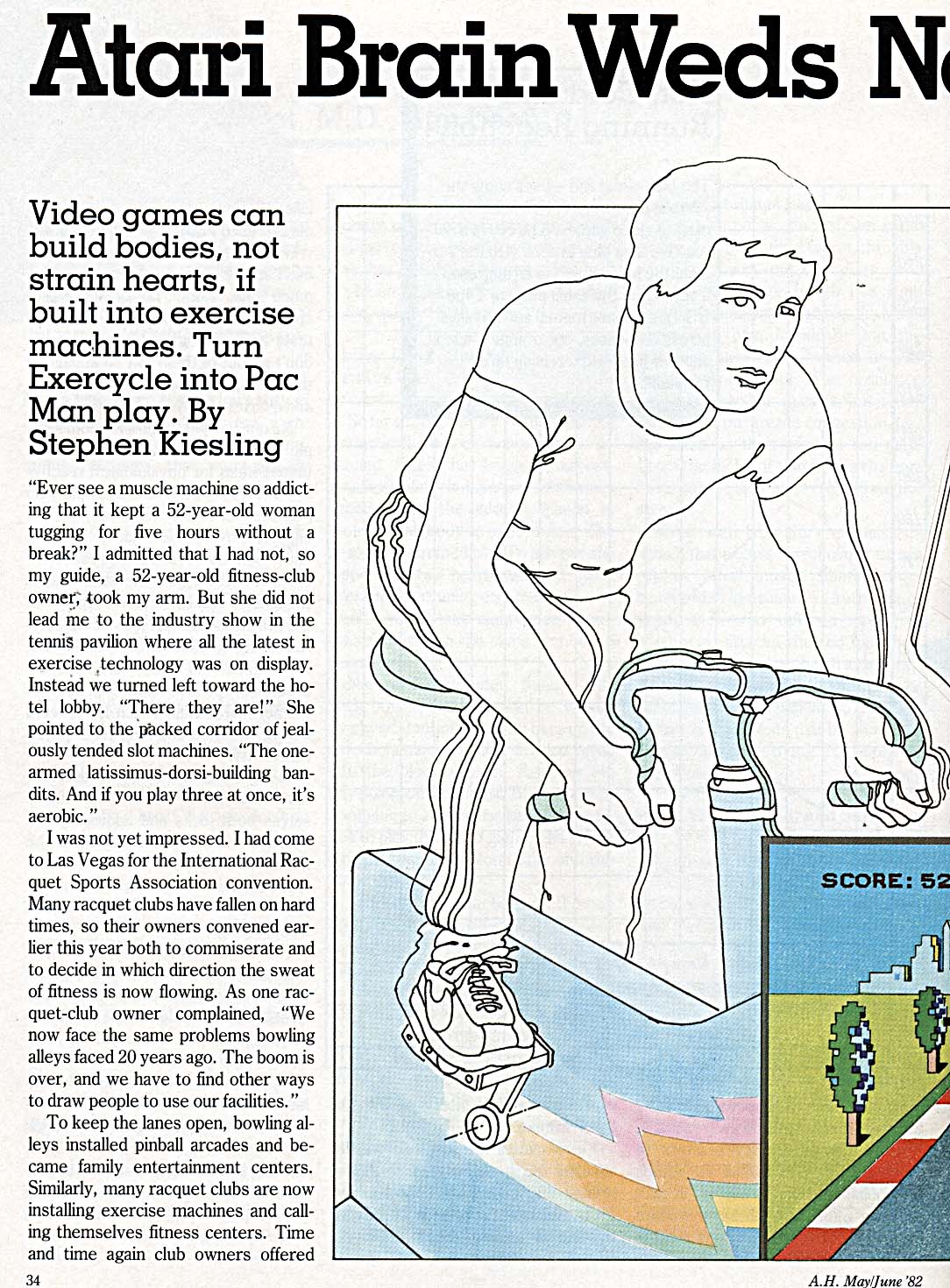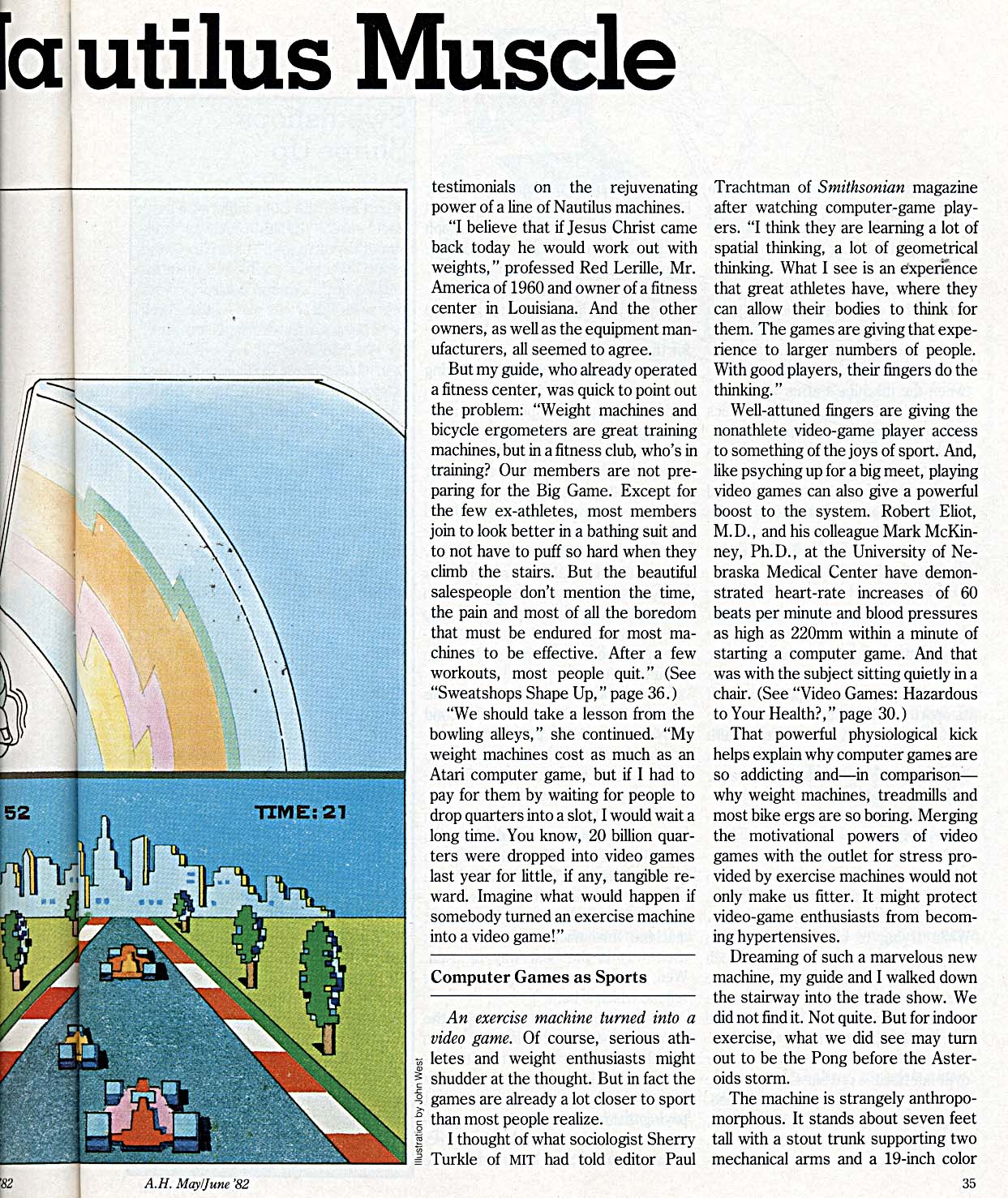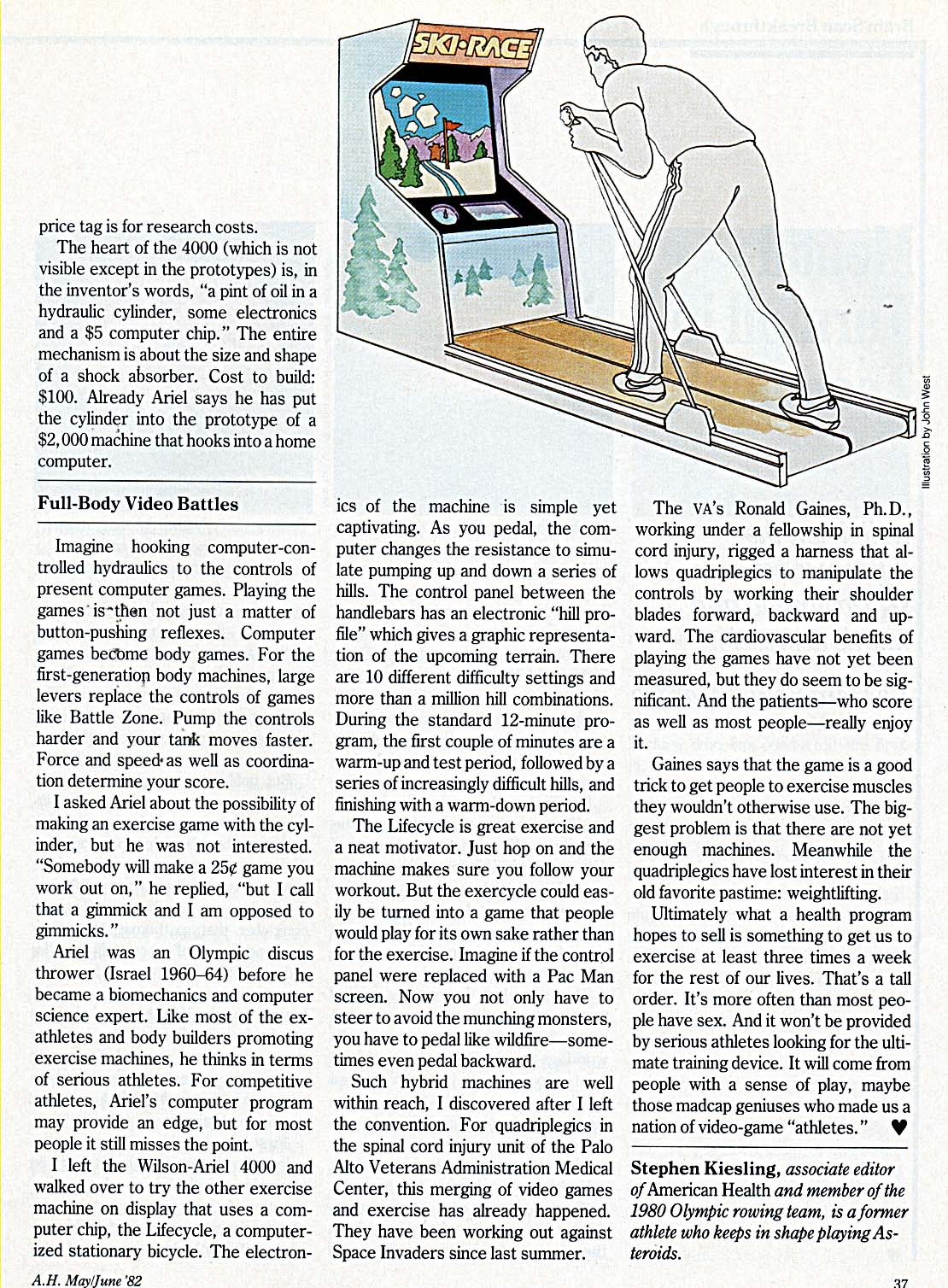Atari Brain Weds Nautilus Muscle
Ever see a muscle machine so addicting that it kept a 52-year-old woman tugging for five hours without a break
By Stephen Kieslihng in American Health on Saturday, May 1, 1982
Fitness Mania: The Intersection of Exercise and Video Games
This article, published in the May/June 1982 issue of American Health, explores the potential of merging video games with exercise machines to motivate people to exercise more. The author, Stephen Kiesling, attended the International Racquet Sports Association convention in Las Vegas, where he observed the shift of racquet clubs into fitness centers, incorporating exercise machines to attract more members.
Kiesling discusses the Wilson-Ariel 4000, a computerized exercise machine that tailors workouts to the user's body and exercise regimen. However, he argues that while such machines may benefit serious athletes, they may not appeal to the average person who exercises for general fitness.
The author also mentions the Lifecycle, a computerized stationary bicycle that simulates different terrains. He suggests that replacing the control panel with a video game screen could make the exercise more engaging.
The article concludes with an example of quadriplegics at the Palo Alto Veterans Administration Medical Center, who have been using a harness to play Space Invaders, demonstrating the potential of combining video games with exercise. Kiesling suggests that the future of fitness may lie in the hands of those who can make exercise feel like play, similar to video games.
Tip: use the left and right arrow keys
Volume I Number II May/June 1982 $2.00
AMERICAN
M
Id
A -b:
Fitness.,'-' Body and Mind
Victims of
Fitness Mania:
Tiny Gymnasts, Dancers.
Pills That You
Must Not Mix
Heart Attack:
New Ways
To Survive
Lilias
& Body
Renewal
Will Video Games
Hurt Your Heart?
Food Additives Update
(N:
Do-It- Yourself Lead Poison Cheese Fights Cavities Sweatsuit Styles Yogi to the Stars Brain Scan Breakthrough Cowboy Boots = Foot Injury Ear- Tube Surgery: Worth It? Stress-Pressure Points
... Dr. Sheehan's racing brain
and quick sleep
Atari Brain Weds N
Video games can build bodies, not strain hearts, if built into exercise machines. Turn Exercycle into Pac Man play. By Stephen Kiesling
"Ever see a muscle machine so addicting that it kept a 52-year-old woman tugging for five hours without a break?" I admitted that I had not, so my guide, a 52-year-old fitness-club owner, took my arm. But she did not lead me to the industry show in the tennis pavilion where all the latest in exercise technology was on display. Instead we turned left toward the hotel lobby. "There they are!" She pointed to the packed corridor of jealously tended slot machines. "The onearmed latissimus-dorsi-building bandits. And if you play three at once, it's aerobic. "
I was not yet impressed. I had come to Las Vegas for the International Racquet Sports Association convention. Many racquet clubs have fallen on hard times, so their owners convened earlier this year both to commiserate and to decide in which direction the sweat of fitness is now flowing. As one racquet-club owner complained, "We now face the same problems bowling alleys faced 20 years ago. The boom is over, and we have to find other ways to draw people to use our facilities."
To keep the lanes open, bowling alleys installed pinball arcades and became family entertainment centers. Similarly, many racquet clubs are now installing exercise machines and calling themselves fitness centers. Time and time again club owners offered
34
A.H. May/June '82
fa utilus Muscle
A.H. May/June 82
testimonials on the rejuvenating power of a line of Nautilus machines.
"I believe that if Jesus Christ came back today he would work out with weights," professed Red Lerille, Mr. America of 1960 and owner of a fitness center in Louisiana. And the other owners, as well as the equipment manufacturers, all seemed to agree.
But my guide, who already operated a fitness center, was quick to point out the problem: "Weight machines and bicycle ergometers are great training machines, but in a fitness club, who's in training? Our members are not preparing for the Big Game. Except for the few ex-athletes, most members join to look better in a bathing suit and to not have to puff so hard when they climb the stairs. But the beautiful salespeople don't mention the time, the pain and most of all the boredom that must be endured for most machines to be effective. After a few workouts, most people quit." (See "Sweatshops Shape Up, " page 36.)
"We should take a lesson from the bowling alleys," she continued. "My weight machines cost as much as an Atari computer game, but if I had to pay for them by waiting for people to drop quarters into a slot, I would wait a long time. You know, 20 billion quarters were dropped into video games last year for little, if any, tangible reward. Imagine what would happen if somebody turned an exercise machine into a video game!"
Computer Games as Sports
An exercise machine turned into a video game. Of course, serious athletes and weight enthusiasts might shudder at the thought. But in fact the
T games are already a lot closer to sport
o than most people realize.
I thought of what sociologist Sherry Turkle of MIT had told editor Paul
S2
Trachtman of Smithsonian magazine after watching computer-game players. "I think they are learning a lot of spatial thinking, a lot of geometrical thinking. What I see is an experience that great athletes have, where they can allow their bodies to think for them. The games are giving that experience to larger numbers of people. With good players, their fingers do the thinking. "
Well-attuned fingers are giving the nonathlete video-game player access to something of the joys of sport. And, like psyching up for a big meet, playing video games can also give a powerful boost to the system. Robert Eliot, M. D., and his colleague Mark McKinney, Ph.D., at the University of Nebraska Medical Center have demonstrated heart-rate increases of 60 beats per minute and blood pressures as high as 220mm within a minute of starting a computer game. And that was with the subject sitting quietly in a chair. (See "Video Games: Hazardous to Your Health?," page 30.)
That powerful physiological kick helps explain why computer games are so addicting and-in comparisonwhy weight machines, treadmills and most bike ergs are so boring. Merging the motivational powers of video games with the outlet for stress provided by exercise machines would not only make us fitter. It might protect video-game enthusiasts from becoming hypertensives.
Dreaming of such a marvelous new machine, my guide and I walked down the stairway into the trade show. We did not find it. Not quite. But for indoor exercise, what we did see may turn out to be the Pong before the Asteroids storm.
The machine is strangely anthropomorphous. It stands about seven feet tall with a stout trunk supporting two mechanical arms and a 19-inch color
35
television monitor which stares down from the top. Admittedly, the beast is not yet a game. Wilson Sporting Goods is introducing it as the ultimate training device.
A touch of the mechanical arm summoned the computer. WELCOME TO THE WILSON-ARIEL 4000 flashed across
the screen. A young gymnast in a white leotard positioned herself between the machine's arms while Gideon Ariel, Ph.D., the biomechanics and computer science expert who invented the 4000, punched directions into a small keyboard. A moment later the display changed to diagrams and instructions for her first exercise, the military press.
Your Solid-State Coach
The gymnast had already been through the brief diagnostic program to acquaint the computer with her body. When shetmoved the bar to the proper height, the computer beeped its approval. This summer, when the 4000 becomes available in health clubs, each user will simply insert a special exercise cassette into a reader to program each of the exercise stations for his particular body and exercise regimen.
Then the machine becomes a coach, telling you what exercises you will do in what order, and how much rest time you will spend between exercises. While trying to cheer you on with beeps, it also determines how much resistance you will push against, the speed at which you will push and the amount, if any, that the resistance will change through your range of motion.
When the gymnast pressed the bar over her head, a red bar shot up on the screen. The computer beeped. "Eighty-four pounds," said Ariel, reading the numbers beside the graph. "That's an average of 84, with a maxi
mum of 110 and a minimum of 32. " She lifted the bar over her head again and again. Each time a new bar graph sprung up beside the last one, until the computer beeped for her to stop. Then a new graph filled the screenshowing in bright red and green a curve of the total work she had done for the set, superimposed on the optimum curve that she should be working toward. Ariel pushed another button and a nearby printer spewed out a paper copy of each graph for her files.
Ariel's machine had just been warming up on those presses. "We'll put her force curve on the screen again to see where in her range of motion she is weakest. We want to build where her force dropped." Ariel punched a few more buttons. "Now the computer knows where she is weak, and when she tries again, the computer will stop the bar for one second to overemphasize that point. It's called stickingpoint training. "
Sure enough, the next time she pressed the bar it stuck for a second midway through the lift and then continued. Ariel put her new force curve on the screen to demonstrate the extra work put on her weak point.
"You see," continued Ariel, "with my machine you can work the muscles any way you want. We still need to do more research to find out which is the best way to train, but whatever it is, this machine will do it. Other weight machine manufacturers claim that their way is the best way to train. Well, my machine will do any way. Just tell me which is best."
The cost of the full 4000 line-the primary machine, the leg extension machine and the computerized treadmill-has been set tentatively at $75,000, including the computer. But paying that much is probably comparable to paying $395 for the first electronic calculators. A large part of the
Sweatshops
Shape Up
The 1979 Federal Trade Commission report on health clubs might well have been called "Health Clubs as Consumer Sweatshops." According to the report, would-be exercisers were inveigled into signing contracts with promises and prices that might as well have been written in disappearing ink.
"We had over 500 complaints a year," says Mark E. Smith, assistant attorney general for the state of Wisconsin, who testified at the FTC hearings. But Smith quickly adds, "We hardly have any complaints now."
Why? New laws in 11 states require that all services be written into the contract, and customers have a threeday cooling-off period to reconsider. But clubs also have found that they don't need hard-sell tactics. The selling is done well before customers pass through their doors.
One center's sales rep calls it "the Rocky syndrome." Victims cart themselves off to theaters, emerge high on Chariots of Fire and race to join a fitness center where $400 seems a small price to pay to wrestle with Nautilus machines, pound the treadmill. and relax in a well-earned sauna.
The flow of new members-up to 10 a day at a branch of one New York City chain-is the backbone of urban fitness centers. Unfortunately for customers, the Rocky syndrome is not chronic. According to Harry Snyder, president of Consumers Union, the act of paying the fees cures the symptoms. After three or four workouts, 70% quit, and their dues keep the doors open for the few who do work out and the many outside who have yet to catch fitness mania.
Ironically, the added motivation of video exercise machines might not only attract new members. It could backfire by keeping the old ones coming back again and again-filling the clubs to bankruptcy.
36
A.H. MaylJune 82
price tag is for research costs.
The heart of the 4000 (which is not visible except in the prototypes) is, in the inventor's words, "a pint of oil in a hydraulic cylinder, some electronics and a $5 computer chip." The entire mechanism is about the size and shape of a shock absorber. Cost to build: $100. Already Ariel says he has put the cylinder into the prototype of a $2, 000 machine that hooks into a home computer.
Imagine hooking computer-controlled hydraulics to the controls of present computer games. Playing the games' is-then not just a matter of button-pushing reflexes. Computer games become body games. For the first-generation body machines, large levers replace the controls of games like Battle Zone. Pump the controls harder and your tank moves faster. Force and speed as well as coordination determine your score.
I asked Ariel about the possibility of making an exercise game with the cylinder, but he was not interested. "Somebody will make a 25� game you work out on," he replied, "but I call that a gimmick and I am opposed to gimmicks."
Ariel was an Olympic discus thrower (Israel 1960-64) before he became a biomechanics and computer science expert. Like most of the exathletes and body builders promoting exercise machines, he thinks in terms of serious athletes. For competitive athletes, Ariel's computer program may provide an edge, but for most people it still misses the point.
I left the Wilson-Ariel 4000 and walked over to try the other exercise machine on display that uses a computer chip, the Lifecycle, a computerized stationary bicycle. The electron
ics of the machine is simple yet captivating. As you pedal, the computer changes the resistance to simulate pumping up and down a series of hills. The control panel between the handlebars has an electronic "hill profile" which gives a graphic representation of the upcoming terrain. There are 10 different difficulty settings and more than a million hill combinations. During the standard 12-minute program, the first couple of minutes are a warm-up and test period, followed by a series of increasingly difficult hills, and finishing with a warm-down period.
The Lifecycle is great exercise and a neat motivator. Just hop on and the machine makes sure you follow your workout. But the exercycle could easily be turned into a game that people would play for its own sake rather than for the exercise. Imagine if the control panel were replaced with a Pac Man screen. Now you not only have to steer to avoid the munching monsters, you have to pedal like wildfire-sometimes even pedal backward.
Such hybrid machines are well within reach, I discovered after I left the convention. For quadriplegics in the spinal cord injury unit of the Palo Alto Veterans Administration Medical Center, this merging of video games and exercise has already happened. They have been working out against Space Invaders since last summer.
The VA's Ronald Gaines, Ph.D., working under a fellowship in spinal cord injury, rigged a harness that allows quadriplegics to manipulate the controls by working their shoulder blades forward, backward and upward. The cardiovascular benefits of playing the games have not yet been measured, but they do seem to be significant. And the patients-who score as well as most people-really enjoy it.
Gaines says that the game is a good trick to get people to exercise muscles they wouldn't otherwise use. The biggest problem is that there are not yet enough machines. Meanwhile the quadriplegics have lost interest in their old favorite pastime: weightlifting.
Ultimately what a health program hopes to sell is something to get us to exercise at least three times a week for the rest of our lives. That's a tall order. It's more often than most people have sex. And it won't be provided by serious athletes looking for the ultimate training device. It will come from people with a sense of play, maybe those madcap geniuses who made us a nation of video-game "athletes." V
Stephen Kiesling, associate editor of American Health and member of the 1980 Olympic rowing team, is a former athlete who keeps in shape playingAsteroids.
Full-Body Video Battles
-
- Mav/lune'82





